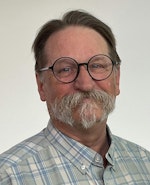Researchers set briefings on demonstrating high-altitude optical relay for battlefield power distribution
ARLINGTON, Va. – U.S. military researchers will brief industry later this month on a project to mature enabling technologies for a future high-altitude optical relay to create scalable on-demand power networks able to distribute about 10 kilowatts of electricity to military users as far away as 125 miles.
Officials of the U.S. Defense Advanced Research Projects Agency (DARPA) in Arlington, Va., will conduct industry-day briefings from 9 a.m. to 5 p.m. on Thursday 29 May 2025 for he second phase of the DARPA Persistent Optical Wireless Energy Relay (POWER) program.
Briefings will be at the DARPA Conference Center, 675 N. Randolph St., in Arlington, Va. Briefings will be at the controlled unclassified information (CUI) security level.
Meetings will provide information to potential proposers on the objectives of the second phase of the DARPA POWER program, in advance of a planned program solicitation for phase 2. Advance registration is required.
Power-beaming optical relay
POWER seeks to demonstrate a power-beaming optical relay not only as a resilient multipath alternative for expeditionary energy transport, but also to enable small-yet-persistent manned and unmanned aircraft to provide on-demand power for a wide range of military missions.
POWER optical technologies are expected to create an airborne relay capable of redirection, wavefront correction, and energy harvesting of optical beams. The ultimate goal is to use three airborne relay nodes hosted on existing aircraft to transmit energy from a ground source laser to 60,000 feet in altitude, and back down to a ground receiver 125 miles away.
RTX Raytheon in McKinney, Texas, won a $10 million contract for the POWER project's first phase in August 2023. A second part of the program, POWER Receiver Array Demonstration (PRAD), began in fall 2024.
POWER phase 2 seeks rapidly to mature and demonstrate a simulated ground-air-ground relay link at the White Sands Missile Range High Energy Laser Test Facility (HELSTF), N.M.
This effort will exercise interfaces and overall operations to build confidence that full-scale designs will meet overall POWER goals. Several performers are expected to use largely commercial-off-the-shelf components and heavyweight custom hardware in this demonstration.
To account for degradation of beam quality as the beam transits atmospheric disturbances, Raytheon is developing a relay able to correct the optical wavefront as needed, and harvest energy from the optical beam to provide on-board auxiliary power.
POWER seeks to balance energy generation, storage, and distribution for military missions by capitalizing on power beaming for near- instantaneous energy transport.
Military power today relies primarily on liquid fuels like jet fuel, gasoline, and diesel fuel, which are vulnerable to enemy attack and require significant infrastructure. Instead, POWER seeks to reduce the military's dependence on liquid fossil fuels, their delivery, and storage capacity.
Rapid network reconstruction
Speed-of-light energy transport through a multipath network would enable rapid reconstitution under attack, graceful degradation, and resilience by re-routing energy through the network in a matter of seconds or minutes, and restoring full capability by replacing nodes in minutes or hours.
The POWER program seeks to deliver 10 kilowatts of laser energy to the final ground node using a 50-kilowatt source laser, transmitted through three airborne relay nodes using system apertures smaller than one meter diameter.
Companies interested in attending the POWER phase 2 briefings should register online no later than 21 May 2025 online at https://creative.spa.com/darpa/tto/power/id/2025/may/. Email questions or concerns to Paul Jaffe, the POWER program manager, at [email protected]. More information is online at https://sam.gov/opp/e8a7ffa9514248f88fc972f189f1bf5b/view.

John Keller | Editor-in-Chief
John Keller is the Editor-in-Chief, Military & Aerospace Electronics Magazine--provides extensive coverage and analysis of enabling electronics and optoelectronic technologies in military, space and commercial aviation applications. John has been a member of the Military & Aerospace Electronics staff since 1989 and chief editor since 1995.

